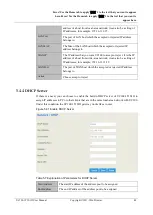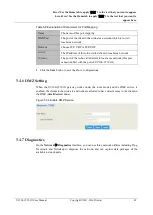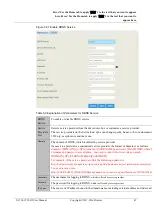
Error! Use the Home tab to apply
标题
1 to the text that you want to appear
here.Error! Use the Home tab to apply
标题
1 to the text that you want to
appear here.
UC100-1T1S1O User Manual
Copyright©2011-2016 Dinstar
47
Status
The static route is enabled or disabled
5.4.10
UPnP Client
UC100-1T1S1O can serve as an UPnP client. When UC100-1T1S1O is deployed at a
local-area network and its outbound router supports the UPnP function, you can enable the
UPnP function on the
Network
UPnP
Client interface of the UC100-1T1S1O device, and
thus its outbound router is notified by the UPnP protocol to carry out port mapping.
For example, the public IP address of outbound router is 172.16.20.12, and the external port
configured on UC100-1T1S1O is 8080. When UPnP HTTP is enabled, the router will create a
port mapping from external HTTP port 8080 to intranet HTTP port 80, and thus clients in
public network can visit the UC100-1T1S1O gateway which is in local-area network through
entering 72.16.20.12:8080.
Figure 5-39 UPnP Client
5.4.11
VPN Client
VPN
(
Virtual Private Network
)
is a network technology that creates a secure remote network
connection over a public network through encrypted tunnel and conversion of data’s
destination address. UC100-1T1S1O can serve as a VPN client to connect with VPN server.
UC100-1T1S1O supports the following VPN protocols:
Layer 2 Tunneling Protocol (L2TP)
is a protocol used to package data of PPP link layer and
transmit the data between two sites over the Internet through a tunnel.
Point-To-Point Tunneling Protocol
(PPTP)
is another tunneling protocol used to connect a
remote client to a private server over the Internet. PPTP is an enhanced security protocol















































